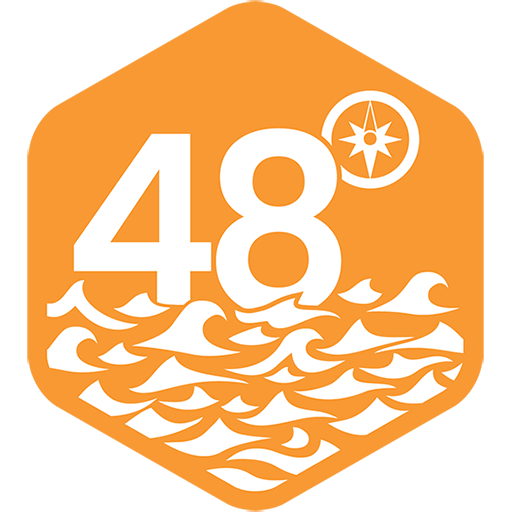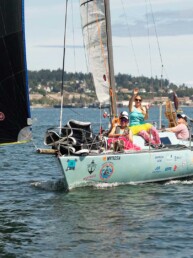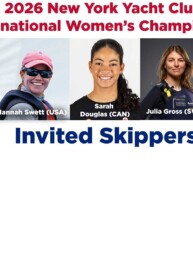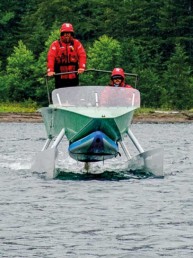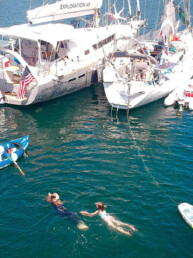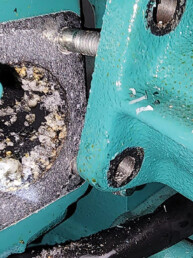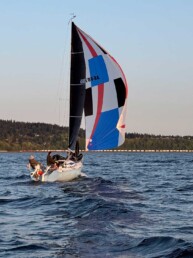It’s always a pleasure to go sailing on one of the new Beneteau Oceanis “point-one” series designs, and it is interesting to track their evolution. The “point-one” versions are characterized by a more modern aesthetic while adjusting the compromise slider slightly in the direction of performance compared to previous Beneteau Oceanis designs. To be sure, they still aim to be (and succeed at being) very comfortable, easy to sail cruising vessels.
I recently got to head out on the newest in the “point-one” line in Seattle, the Beneteau Oceanis 34.1. This is a lot of boat in a comparatively small package. The hull is just 32-feet-8-inches in length, and it stretches to just over 35 feet with the bowsprit on the downwind package. It is lighter weight than the boat it replaces in the Oceanis line, the 35.1, by a little more than 1,000 pounds, but retains similar dimensions as well as its ballast numbers for both the fixed deep and shoal keel options; the total ballast is reduced significantly with the performance retractable keel, because the new keel design is six inches deeper than its predecessor when all the way down. Along with more sail area, the 34.1 will clearly be a cruiser with more get-up-and-go.
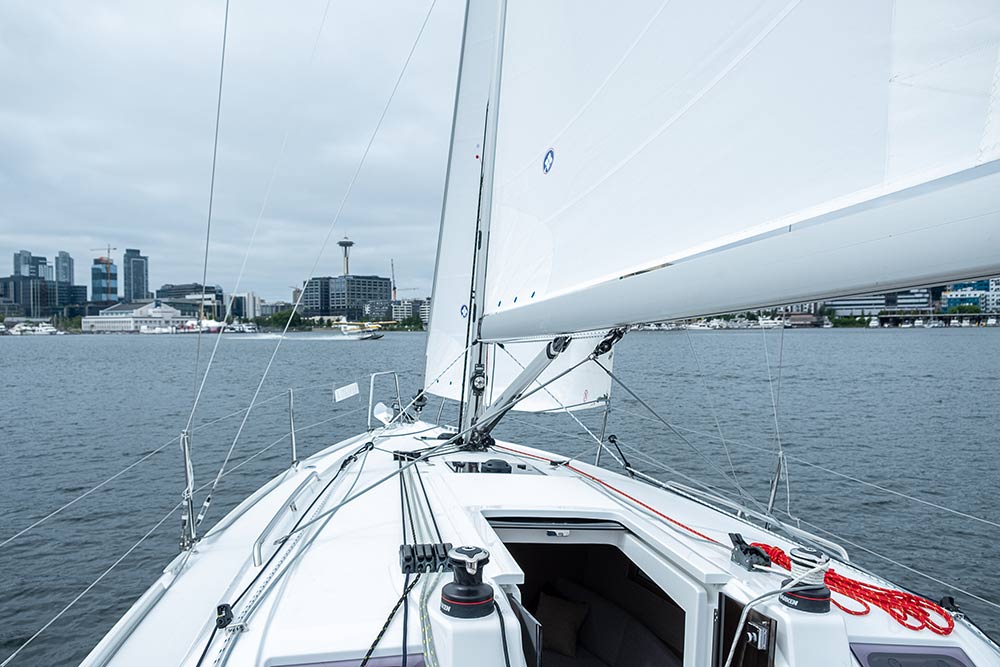
Though it’s the second-smallest current Oceanis, the 34.1 neither looks nor feels small, and it’s still incredibly easy to operate. You can get the 34.1 in a three-cabin model, though that’s not the configuration I’d choose. Based on the two-cabin model I sailed, there is ample room for comfortable cruising for a small family or a couple with guests for a week in the islands, or even a season in the Inside Passage or Alaska.
Approaching it on the dock, the Oceanis 34.1 is a handsome boat, sharing a number of attributes with other modern European production boats like hull portlights and a full-length chine. I think these designs in general, and this one in particular drawn by Marc Lombard, are getting ever-more refined — a little more comfortable in their own skin.
The chine is a critical element of the design, providing more interior volume while narrowing to a more efficient waterline with reduced wetted surface. Additionally, it adds hull form stability and righting moment at certain angles of heel. As a cherry on top, the added breadth in the forward quarter should increase bow buoyancy, helping keep the deck drier and the nose up in wavy conditions.
One of the first things I noticed about the 34.1 was its two-spreader rig without backstays. I’m a fan of a backstay personally (what racer-at-heart with the constant need to tweak settings isn’t), but there’s no denying that the removal of the backstay, another update from the 35.1, really opens up the back of the cockpit. In order to support the mast, the spreaders are swept aft, and the shrouds are set as wide as possible with outboard chainplates.
I dropped the transom swim step and was pleased to see a block-and-tackle system was employed. It’s not exactly lightweight, but one of the big advantages of a smaller boat is the reduced loads, and the simplicity of the supporting systems. Should there be a problem with the swimstep rigging in a remote location, you won’t need to sleuth for the nearest electrician or hydraulic specialist; a few dollars in line and a DIY install will likely resolve the issue.
Overall, I love the cockpit. The proliferation of cockpit layouts with nearly full-beam helm areas and bench seats with backrests forward is one of my favorite trends in modern design. It’s well executed on the 34.1, and I liked the hinged stow-able helm seats for a driver who prefers to sit rather than stand.
The cockpit table is permanently installed, with a broad section bordered by handrails on top to place things even when both hinging leaves are down; and at the aft end are two of the cockpit’s six (!) cupholders. There’s plenty of room to walk on either side of the table, but it will still offer a nice foot-push for crew on the bench when the breeze is up.
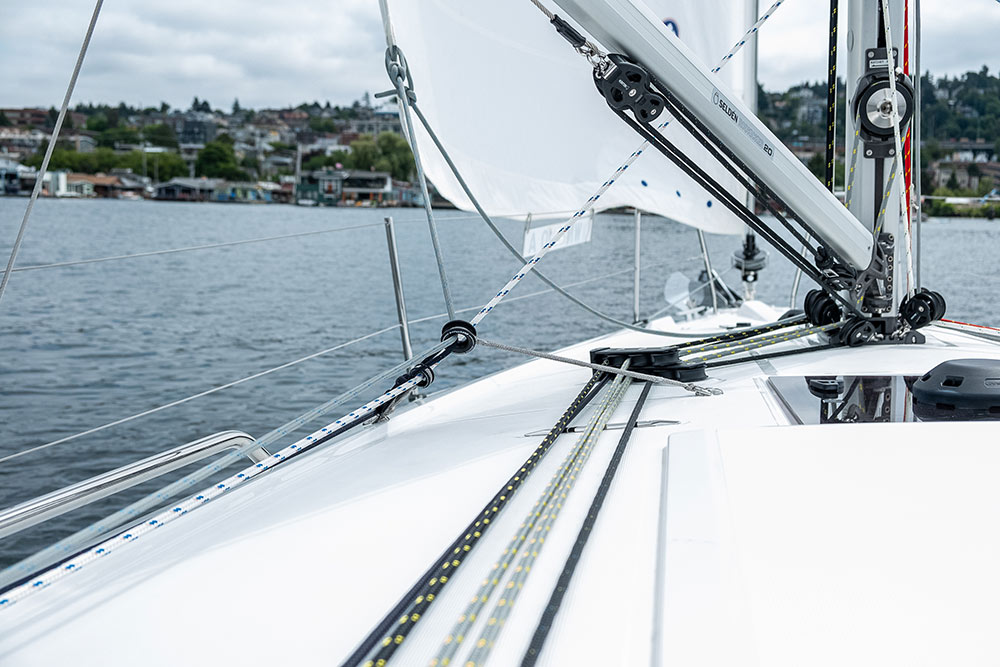
Once we got off the dock, the main cockpit compromise I encountered was that the primary winches, which pull double duty for both the jib and main sheets, are really far aft. That’s a huge advantage if you’re sailing solo or as the only person running the boat while others relax; but I kept finding myself gravitating to trimming from aft of the wheels, even when I wasn’t driving. That way, I could see the sail more easily and it felt more ergonomic to me. If you wanted a crew to trim from the benches, they can’t really face the sails effectively when they do so. No value judgment here, though, many buyers will love the location of these winches.
We motored out onto Lake Union, and true to the design priority of ease, we unfurled the in-mast-furling main and then the jib, and had the engine off not more than a few minutes after we turned it on at the dock. To me, the 34.1’s elegant lines showed their function as we started to move under sail, with a predictable motion that I’m confident would be reassuring in the moderate seaways of the Pacific Northwest. A part of this feel is that the space on deck feels bigger than the boat actually is, but its interaction with the wind and water is more reflective of the smaller, lighter, slightly more powered-up Oceanis it is.
As so often seems to be the case for my boat tests, the wind gods only granted us light-to-moderate airs for the test. Still, I got a good feel for the way the Oceanis 34.1 sails. In a modern production cruiser’s push-pull between ease and performance, the choice to forgo the self-tacking jib for the 106% furling genoa provided a performance benefit and a little more handling effort; and this was balanced by the performance sacrifice of an in-mast-furling main that won’t make you break a sweat when setting the sail.
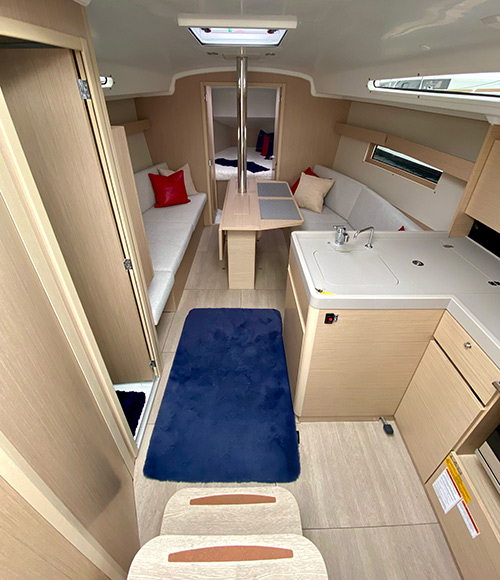
With both sails pulling, I immediately appreciated the clever floating jib leads. The fairlead ring through which the sheets run was anchored by a short length of line on either side — with the inboard one fixed and the outboard one adjustable. The result is that easing the lead up (opening the leech and flattering the foot) also brings the lead inboard, which should increase efficiency with more sheet trim in building breeze until you start getting overpowered. Meanwhile, if you bring the lead down (closing the leech and rounding the foot) as you would in lighter air, the lead moves outboard and opens the slot to keep light air flowing through. The leads were easy to adjust and offered a nice array of efficient looking shapes.
The main, on the other hand, felt more challenging to shape as effectively, which is possibly due to the cut of the sail or the design requirements for the in-mast furling system to work as beautifully as it did. This is where my design desires run a bit astray from what this boat is really all about. Even with some very smart sail-handling systems, this is clearly a boat that wants to help its sailors relax, while still making some nice cruising miles in comfort and style. Hard to argue with that, even if I’d like more sail controls!
In the day’s conditions, the 34.1 was happiest on a on a reach, anywhere from close to broad. With a bit more wind, I’m confident the performance both closer to and farther off the breeze would have impressed significantly more. For downwind sailing, the bowsprit, which comes equipped with a bob stay, is perfectly set-up for a big Code Zero or asymmetrical kite.
We tested the quiet 30-horsepower inboard on the way in. Revving up and down, it seemed cruising speed would be about 6.5 knots, which is solid for a boat of this size — another hat-tip to this more performance-oriented hull.
Down below, an airy Beneteau-style interior with light-colored finishes makes the most of the loads of light coming in from the hull portlights and deck hatches. It was a pretty standard cruising boat layout, with the galley to starboard, and the head with a separate shower stall (albeit a small one) to port. Two double berth cabins flank the spacious salon fore and aft. The completely stow-able navigation table to port was a fun feature that would certainly help accommodate another guest or two for dinner should the weather turn damp.
On the whole, it’s pretty extraordinary all you get in a boat like this. It is the picture of a modern production cruiser, and it’ll make many more happy miles under sail than you might assume. All the while, you and your crew can be certain you wouldn’t be suffering from the lack of comfort or ease. Especially now that I have my own young family, a boat like this starts ticking a lot of boxes, and I’m confident I won’t be alone in that feeling.
Joe Cline is the Managing Editor of 48° North. Special thanks to Tori Parrot and Signature Yachts Seattle for taking me sailing.
Joe Cline
Joe Cline has been the Managing Editor of 48° North since 2014. From his career to his volunteer leadership in the marine industry, from racing sailboats large and small to his discovery of Pacific Northwest cruising —Joe is as sail-smitten as they come. Joe and his wife, Kaylin, have welcomed a couple of beautiful kiddos in the last few years, and he is enjoying fatherhood while still finding time to make a little music and even occasionally go sailing.
